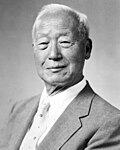| ||||||||||||||
|
| ||||||||||||||
President | ||||||||||||||
| ||||||||||||||
| ||||||||||||||
Vice-president | ||||||||||||||
| ||||||||||||||
| ||||||||||||||
Presidential and vice- presidential elections were held in South Korea on 20 July 1948, following the Constitutional Assembly elections in May. The president was to be elected by the members of the National Assembly, as instructed by the 1948 Constitution. Of the 198 members of the National Assembly, 196 were present for the vote. A candidate required two-thirds of the votes cast to win. Syngman Rhee was elected with 180 votes, and took over the government to oversee the transfer of power from the United States Army Military Government in Korea.[1]
An important role was played in the run-up to the election by the dispute between Rhee and Kim Ku over the issue of establishing a separate government in the southern part of Korea, instead of including the communist-controlled north. Kim rejected the idea of separate elections, and had boycotted the Constitutional Assembly elections in May, instead campaigning for a united Korea. He also split from the National Alliance for the Rapid Realization of Korean Independence to form the Korea Independence Party.[2] Despite Kim's refusal to take any part in a South-only government and therefore in this election, 13 members cast their votes for Kim.
In the event, Kim's split allowed Rhee to consolidate power over NARRKI and, in 1951, form the Liberal Party, enabling his rule over South Korea until the April Revolution in 1960.[2]
- ^ Andrea Matles Savada; William Shaw, eds. (1990). "The Syngman Rhee Era, 1946-60". South Korea: A Country Study. Washington: GPO for the Library of Congress. p. 33. ISBN 978-0844407364.
- ^ a b Haruhiro Fukui; Colin A. Hughes (1985). Political Parties of Asia and the Pacific. Vol. I. Greenwood Press. p. 674. ISBN 978-0-313-21350-2.


